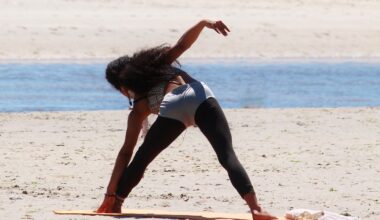Building Achilles Tendon Strength Through Targeted Exercises
Achilles tendon strength is crucial for runners, yet often overlooked. Strengthening this tendon can prevent injuries and improve performance significantly. Runners typically experience intense stress in their lower legs, making them susceptible to various injuries. Focusing on the achilles tendon offers numerous advantages. A strong tendon ensures efficient energy transferduring running. Therefore, incorporating specific exercises into a training program can enhance performance while reducing the likelihood of injury. Strength exercises should be gradual to allow the tendon to adapt to increased demands. Targeted workouts can help improve flexibility and strength, ultimately leading to better overall running. Plyometric exercises, such as jump squats or box jumps, make an excellent addition to an established training routine. Additionally, eccentric exercises have shown promising results. Eccentric calf raises are particularly effective in rehabilitating and building strength in the achilles tendon. These exercises target both strength and nerve adaptation, promoting improved control and balance. Moreover, proper technique and form are paramount. Runners should focus on maintaining correct posture while performing each exercise, ensuring an optimal connection between body parts. A combination of flexibility and strength training will yield significant results in terms of running efficiency.
Secondly, understanding the anatomy of the achilles tendon is vital for runners engaged in strength training. It serves as a connection between the calf muscles and the heel bone. Knowing the tendon’s structure helps athletes choose effective exercises to enhance strength and resilience. The achilles tendon is particularly susceptible to overuse injuries. Thus, effective training can positively impact runners’ longevity in the sport. Incorporating balance training can complement strength exercises well. Utilizing tools like balance boards or stability balls can engage stabilizing muscles in the lower legs. Adding single-leg exercises into routines significantly enhances strength and stability while isolating the achilles tendon. For example, single-leg deadlifts challenge balance and strength. Incorporating variations, such as pairs or more complex movements, encourages overall muscle tightening. Furthermore, cross-training offers additional benefits. Engaging in lower-impact activities while maintaining adequate strength such as swimming or cycling aids recovery. These activities allow the achilles tendon time to strengthen while avoiding further damage. Moreover, integrating stretching routines before and after workouts promotes flexibility. Increased flexibility in the calf region allows runners to achieve optimal running form, decreasing the risk of injury and enhancing performance.
Key Exercises for Building Strength
When considering exercises for strengthening the achilles tendon, calf raises should be among the top priorities. These can be performed on flat surfaces or elevated platforms for added intensity. Begin with both feet on a step, rising onto the balls of the feet. As your strength progresses, transition to single-leg variations. This engages stabilizing muscles in the lower leg, improving control. Additionally, eccentric calf raises are a must-include exercise. Begin in a standing position, rise on both feet, then slowly lower back down on one foot. This method significantly strengthens the tendon’s capacity. Moreover, it targets different muscle groups effectively, promoting overall lower leg health. Another beneficial exercise includes the heel drop, which strengthens the tendon while allowing it to stretch. While standing on the edge of a step, let heels drop down for a deeper stretch. Return to the starting position and repeat. Incorporating resistance bands can also boost effectiveness. By wrapping a band around the balls of the feet while performing calf raises, the added resistance enhances strength over time. Lastly, integrating plyometrics will aid in developing power and connectivity between muscles, maximizing running efficiency.
Maintaining an appropriate recovery period between exercises is equally important for building strength. Runners often overlook this critical aspect, leading to potential overuse injuries. Muscles and tendons need time to recover and adapt following intense workouts targeting the achilles tendon. Implementing rest days into the training schedule promotes optimal gains. Moreover, understanding signs of overtraining lends insight into when adjustments are necessary. Warning signs may include persistent pain, swelling, or reduced strength. Runners are encouraged to consult professionals if symptoms arise. Incorporating proper recovery techniques, such as icing and yoga, can relieve strain on the achilles tendon. Active recovery sessions featuring low-impact workouts enhance circulation, facilitating healing. Furthermore, proper nutrition supports recovery through adequate protein intake. Ensuring sufficient hydration levels assists in muscle repair. Runners should prioritize overall wellness by consuming a balanced diet rich in vitamins and minerals. These nutrients boost overall performance and tendon health. Likewise, incorporating supplements, if necessary, can further support overall strength training goals. Collaborating with a sports dietician will help design a nutrition plan tailored to specific goals, promoting optimal recovery and strength training strategies.
Your Running Technique
Focusing on running technique also significantly influences overall achilles tendon strength, ensuring runners maintain the correct posture. Proper running mechanics minimize stress on the lower legs, allowing the achilles tendon to function efficiently. Additionally, arm swing and stride length are fundamental components to consider. Over-striding can lead to increased load on the tendon. Runners should aim for a mid-foot strike when landing, which will optimize energy conservation and minimize injury risk. This technique promotes a more efficient, faster run while reducing the force transmitted through the achilles tendon. Another element involves varying terrain while training. Running on softer surfaces such as grass or dirt paths decreases impact on joints and tendons, providing a well-rounded approach. Conversely, integrating hill workouts can enhance strength after adapting to lower-impact exercises successfully. Hills engage different muscle groups and encourage greater propulsion power. Including tempo runs at a controlled pace also aids in building endurance and strength over time. Therefore, by focusing on technique backed by scientific principles, runners can establish solid foundations for greater success on their running journeys. Emphasizing sustainable practice creates long-lasting achievements while maintaining overall health.
Incorporating strength training into a regular running routine may require an adjustment phase, especially for those new to this approach. Runners are encouraged to gradually introduce these exercises to avoid unnecessary stress on the achilles tendon. Consistent application and realistic expectations are vital in ensuring progress while minimizing injury risks. Tracking performance through a training log enhances accountability and awareness. Recording exercises, distances, and perceived exertion levels assists in ongoing evaluation of strength progress. For many runners, this log serves as motivation during challenging periods and a valuable tool for recognizing development over time. Seeking guidance from professionals who specialize in sports science can offer insights, tailored programs, and invaluable support. Coaches play an essential role in helping athletes reach their maximum potential. They can provide targeted feedback to refine techniques and optimize performance. Additionally, workout partners can enhance motivation and accountability. Train with friends or fellow runners to share experiences. By working together, runners can exchange ideas, exercises, and benchmarks while pushing each other toward their goals. Celebrating successes along the journey fosters a sense of community and shared triumph, ultimately enhancing the overall running experience.
Conclusion
In conclusion, strengthening the achilles tendon through targeted exercises is paramount for runners. A systematic approach, focusing on flexibility, strength, and technique, promotes long-term health and enhances performance. Awareness of anatomy and proper recovery techniques serves to fortify the tendon against overuse injuries. Runners must educate themselves on the specific exercises, carefully monitoring their patterns as they grow stronger. Prioritizing strength training allows athletes to achieve their full potential while maintaining their passion for running. Embracing a multifaceted training approach ensures continued development. Ultimately, the journey to establish achilles tendon strength will significantly improve overall running efficiency. By dedicating time to this process, runners will be equipped to not only prevent injuries but also elevate their performance on the track or trails. Over time, the integration of strength training will yield tangible results visible in personal bests and strides forward within the running community. Collaboration with coaches, nutritionists, and fellow runners fortifies the strength exercise regimen, creating a supportive network. As each athlete embarks on this journey, remember the importance of achieving goals at one’s own pace. Celebrate progress and remain committed to a life where running nourishes not just the body, but also the spirit.
Establishing a routine built around achilles tendon strengthening promises enhanced performance in the long run. Emphasizing various training principles nurtures a true athlete’s spirit, allowing for growth in both physical and mental realms. Knowledge of techniques, strategies, and proper exercises instills confidence among runners. At the culmination of this journey lies the satisfaction of reaching goals and improving individual performance consistently. Every commitment to strength training solidifies a newfound understanding of the human body’s potential and resilience. Each step paves the way for athletes to become better runners and overall competitors. More importantly, it builds an invaluable sense of accomplishment that propels individuals forward while ensuring they remain grounded in their endeavors. Therefore, athletes should wholeheartedly embrace these principles into their training routines. As they progress, dedication to running and strength training aligns perfectly, creating a harmonious balance that fosters success. Thus, every runner can enjoy the rewards of their hard work, reaping benefits far beyond physical form. Conclusively, this path demonstrates that fortifying the achilles tendon supports vibrant running journeys filled with joy and lasting achievements.


